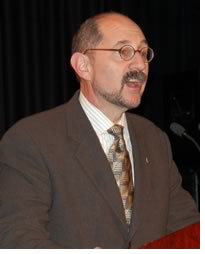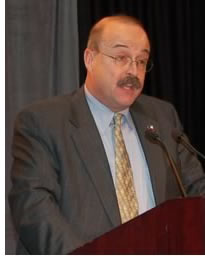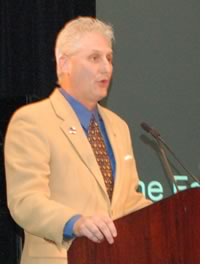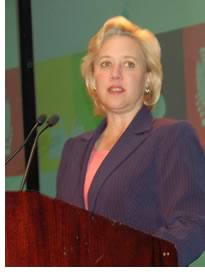

2/2006
Sens. Landrieu, Coleman offer advice for bringing issues home

 To prime Grassroots attendees
for their Capitol Hill visits the following day, AIA national Vice President
Jerry Roller, AIA, outlined the process used by the Board and the national
staff to identify the AIA’s federal legislative priorities at the
conference’s opening session February 8. The four crucial ingredients,
Roller said, are: the AIA’s Public Policies; input from the Board Advocacy Committee, who bring information, discussion,
and guidance on important advocacy issues to the rest of the Board as
well as staff; a constant two-way flow of information about government
advocacy issues on all levels between the national component and the
members, facilitated by the AIA Angle, State Government Network, and
an annual survey of the membership; and the national-component staff,
who think tactically and provide the 24/7 monitoring of the AIA’s
legislative priorities.
To prime Grassroots attendees
for their Capitol Hill visits the following day, AIA national Vice President
Jerry Roller, AIA, outlined the process used by the Board and the national
staff to identify the AIA’s federal legislative priorities at the
conference’s opening session February 8. The four crucial ingredients,
Roller said, are: the AIA’s Public Policies; input from the Board Advocacy Committee, who bring information, discussion,
and guidance on important advocacy issues to the rest of the Board as
well as staff; a constant two-way flow of information about government
advocacy issues on all levels between the national component and the
members, facilitated by the AIA Angle, State Government Network, and
an annual survey of the membership; and the national-component staff,
who think tactically and provide the 24/7 monitoring of the AIA’s
legislative priorities.
AIA Senior Director for Federal Affairs Tom Wolfe then provided an overview of the four “asks,” or topics to be addressed this year with members of Congress and their staffs on February 9, during Grassroots’ Legislative Day on Capitol Hill:
 Small Business Health Care. The AIA will press senators to pass
S.406, the Small Business Health Fairness Act. This bill will allow
the AIA and other associations to form “association health plans” (AHPs)
that can provide affordable health insurance to small businesses. The
House of Representatives passed this legislation last summer, but the
Senate has yet to act on it.
Small Business Health Care. The AIA will press senators to pass
S.406, the Small Business Health Fairness Act. This bill will allow
the AIA and other associations to form “association health plans” (AHPs)
that can provide affordable health insurance to small businesses. The
House of Representatives passed this legislation last summer, but the
Senate has yet to act on it.- Community Restoration and Revitalization Act. AIA members will seek commitment for votes for the House bill (H.R.3159)—which the AIA advocated during last year’s Grassroots Advocacy Day and is sponsored by Rep. Phil English (R-Pa.)—and its soon-to-be-introduced Senate counterpart. This legislation will enhance the current historic rehabilitation tax credits to make them more useful for community revitalization by enlarging to “difficult to develop areas” and allowing the credits to be combined with the low-income tax credit. It will also make the current 10-percent credit available to homeowners.
- Louisiana Recovery Corporation Act. The AIA is asking Congress to pass H.R.4100, sponsored by Rep. Richard Baker (R-La.), or its Senate counterpart, S.2172. This bill will create the Louisiana Recovery Corporation, a federal entity that will purchase properties damaged by last year’s devastating hurricanes. This legislation is a key step in helping Louisiana recover and rebuild.
- Regulate greenhouse gases. AIA members will tell legislators that the AIA supports market-based incentives to reduce the emission of greenhouse gases nationwide. In particular, the AIA endorses a “cap-and-trade” system, similar to that used to reduce sulfur dioxide and nitrogen oxide emissions. This issue arises from the sustainability resolution passed at the AIA 2005 National Convention in Las Vegas and the position statement adopted by the AIA Board in December.
 Wolfe
also introduced the video: “Meeting with Your Legislator,” which
offered helpful tips for the next day’s visits to the Hill. It
was followed by a speech and video presented by Mickey Jacob, AIA, the
national chair of ArchiPAC, the AIA’s political action committee,
on the purpose and importance of a federal PAC. Jacob explained that
having a PAC means “having one voice to get done what we need to
get done.” He reminded the audience that AIA dues dollars cannot
by law fund the PAC; the money has to come from individual contributions. “It’s
an investment in our profession,” he declared.
Wolfe
also introduced the video: “Meeting with Your Legislator,” which
offered helpful tips for the next day’s visits to the Hill. It
was followed by a speech and video presented by Mickey Jacob, AIA, the
national chair of ArchiPAC, the AIA’s political action committee,
on the purpose and importance of a federal PAC. Jacob explained that
having a PAC means “having one voice to get done what we need to
get done.” He reminded the audience that AIA dues dollars cannot
by law fund the PAC; the money has to come from individual contributions. “It’s
an investment in our profession,” he declared.
Landrieu makes case for sustainable wetlands, redevelopment
Mary Landrieu, senior senator from Louisiana, who currently serves on
the Senate Appropriations, Energy and Natural Resources, and Small
Business committees has been prominent in the public eye as she bravely
and compassionately steered her state through the aftermaths of Hurricanes
Katrina and Rita. She wanted personally to “deliver a big thank
you for all you did for Louisiana, New Orleans, and the region,” after
the disaster struck, she told the AIA leaders. In particular, she praised
the members of the state and local AIA components in the region, who
have persevered through their own professional devastation, and who
joined with the national component to assemble the Louisiana
Recovery and Rebuilding Conference in New Orleans in 23 days.
 Landrieu
also “apologized” for taking former AIA Team Vice
President for Government Advocacy Ron Faucheux to
be her chief of staff. “It’s
our blessing to get Ron back to Louisiana,” she said. She also
praised the efforts of Herman “Bubba” Gesser III, AIA, also
on her staff. “Everyone in Louisiana needs a bubba,” she
said, “I’ve
got mine and he’s the best.”
Landrieu
also “apologized” for taking former AIA Team Vice
President for Government Advocacy Ron Faucheux to
be her chief of staff. “It’s
our blessing to get Ron back to Louisiana,” she said. She also
praised the efforts of Herman “Bubba” Gesser III, AIA, also
on her staff. “Everyone in Louisiana needs a bubba,” she
said, “I’ve
got mine and he’s the best.”
Landrieu spoke about the devastation of the hurricanes. “Six months out from Katrina, it has been the worst disaster ever to hit the U.S. coast,” she told the audience. It has caused the greatest population migration since the Civil War, and the destruction of more than 280,000 homes, more than 10 times the amount caused by Hurricane Andrew in 1992. She explained that Louisiana has very little beach; it is an area of marsh and wetlands that is eroding at an alarming pace. “A football field of marsh land is eroding every 30 minutes,” she said. “We could lose it all very quickly if we don’t reinvest in sustainable development.”
Federal monies to help rebuild and redevelop the region—and also to protect its wetlands—also are sorely needed, Landrieu emphasized. Because federal support, especially for H.R. 4100, has not been forthcoming, the state has had to develop its own reinvestment program for people who live there, leaving less money available for public building and infrastructure redevelopment. The region’s very environment, with its port and its oil, gives much to the country, she said. “As architects and people who think about what the world should be like, we need to put our best minds together to think of a better way to get the job done to produce wealth and invest in the coastal communities.”
 Coleman asks for bipartisanship
Coleman asks for bipartisanship
Norm Coleman, best known as a champion of urban issues throughout his
career as a campus organizer in the ’60s, a prosecutor in the ’70s,
solicitor general of Minnesota in the ’80s, to mayor of St. Paul
in the ’90s, and now to the U.S. Senate where he serves as Minnesota’s
junior senator, praised the AIA for being involved in the rebuilding
of the Gulf Region, which he had just visited. The chair of the Senate
Governmental Affairs Committee’s Permanent Subcommittee on Investigations
and a member of the Foreign Relations Committee and the Small Business
and Entrepreneurship Committee told the audience that his experience
as mayor and with the revitalization of the Twin Cities in the 1990s
taught him the importance of “turning to the river” in
urban design. He said that he hopes we get “to do it right” when
we rebuild the Gulf, and he hopes to take part.
Coleman posited that although it might be an unpopular stance at the moment, he believes that Washington needs more lobbyists now. “My best ideas come from home,” he said. “There are thousands of issues and few priorities. You can help us shape priorities.” He offered the following tips for lobbying:
- Lead with the facts
- Guard your credibility
- Create an open door—offer to serve as an information source down the road
- Respect the process and allow for disagreements and different points of view.
The senator talked about three events that he said showed how bipartisan support will enable us to do what needs to get done. The first event was the recent National Prayer Breakfast, which has taken on an international tone, and for which Coleman served as co-chair. He got a diverse group of people—including the King of Jordan and rock singer/activist Bono—to pray for peace in the Middle East. The second event is the swearing in of Supreme Court Justice Samuel Alito. He believes that we should have justices “from both sides of the aisle,” rather than electing them along party lines. The third event was the State of the Union address. “When the President says to do away with foreign oil, that’s a good thing,” Coleman said, to great applause. “He said 25 years, but we should do it in half of that,” he declared, to even greater applause.

These events, Coleman said, show that Americans are capable of great things. “We need to get over the partisan division,” he concluded. “In the words of Norman Vincent Peale, we need to become ‘possibilitarians.’”
Copyright 2006 The American Institute of Architects.
All rights reserved. Home Page ![]()
![]()
With particularly timely publication, AIA President Kate Schwennsen, FAIA, had a letter to the editor published in The Washington Post on February 7 under the banner “Forgetting the Pledge to New Orleans.” In her letter, Schwennsen took the Administration to task for not supporting H.R. 4100 to establish the Louisiana Recovery Corp. to provide for the economic stabilization and redevelopment of those areas of Louisiana that were devastated by Hurricane Katrina. She also described how 700 AIA architects would be visiting the Hill on February 9 to urge passage of the bill. Read the text of Schwennsen’s letter.
![]()